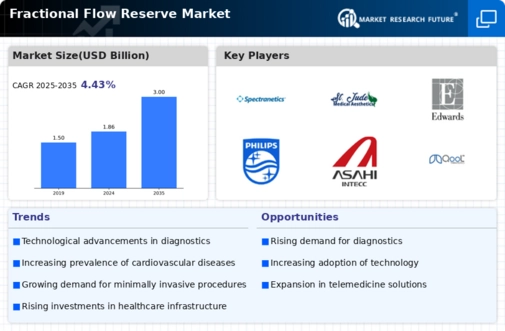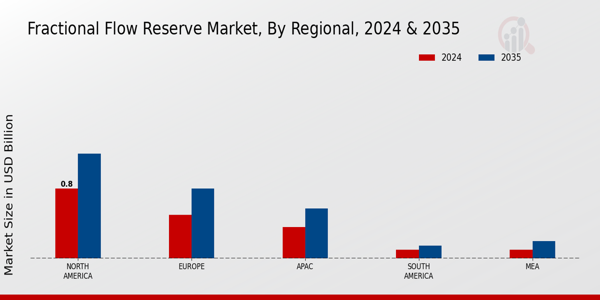Market Growth Projections
The Global Fractional Flow Reserve Market Industry is projected to experience substantial growth in the coming years. With an estimated market value of 1.86 USD Billion in 2024, the industry is expected to expand at a CAGR of 4.44% from 2025 to 2035, reaching approximately 3 USD Billion by 2035. This growth is driven by various factors, including technological advancements, increasing prevalence of cardiovascular diseases, and supportive regulatory environments. The market's trajectory suggests a robust demand for FFR technologies, indicating a promising future for stakeholders in the healthcare sector.
Rising Prevalence of Cardiovascular Diseases
The increasing incidence of cardiovascular diseases globally drives the Global Fractional Flow Reserve Market Industry. As conditions such as coronary artery disease become more prevalent, the demand for advanced diagnostic tools like fractional flow reserve measurement rises. In 2024, the market is projected to reach 1.86 USD Billion, reflecting the urgent need for effective treatment options. Healthcare providers are increasingly adopting FFR technology to enhance patient outcomes and reduce complications associated with coronary interventions. This trend is expected to continue, as the World Health Organization indicates that cardiovascular diseases remain a leading cause of mortality worldwide.
Regulatory Support and Reimbursement Policies
Supportive regulatory frameworks and favorable reimbursement policies play a crucial role in the Global Fractional Flow Reserve Market Industry. Governments and health authorities are increasingly recognizing the importance of FFR in improving patient care and outcomes. As a result, there is a growing trend toward reimbursement for FFR-guided procedures, which encourages healthcare providers to adopt these technologies. This regulatory backing is expected to bolster market growth, as it reduces financial barriers for hospitals and clinics. The anticipated growth trajectory of the market, reaching 3 USD Billion by 2035, is likely to be influenced by these supportive measures.
Technological Advancements in Medical Devices
Innovations in medical technology significantly influence the Global Fractional Flow Reserve Market Industry. The development of more accurate and less invasive FFR measurement devices enhances the diagnostic capabilities of healthcare professionals. These advancements facilitate real-time data acquisition and analysis, leading to improved patient management. As a result, the market is anticipated to grow at a CAGR of 4.44% from 2025 to 2035, reaching an estimated 3 USD Billion by 2035. The integration of artificial intelligence and machine learning into FFR devices further streamlines the diagnostic process, potentially increasing their adoption in clinical settings.
Growing Awareness and Acceptance of FFR Procedures
The rising awareness among healthcare professionals and patients regarding the benefits of fractional flow reserve procedures contributes to the expansion of the Global Fractional Flow Reserve Market Industry. Educational initiatives and training programs have been instrumental in promoting the understanding of FFR's role in guiding coronary interventions. This heightened awareness is likely to lead to increased utilization of FFR measurements in clinical practice, thereby enhancing patient outcomes. As the medical community recognizes the advantages of personalized treatment approaches, the market is expected to witness sustained growth, aligning with the projected market value of 1.86 USD Billion in 2024.
Increasing Investment in Healthcare Infrastructure
The expansion of healthcare infrastructure globally is a significant driver of the Global Fractional Flow Reserve Market Industry. As countries invest in modernizing their healthcare systems, there is a corresponding increase in the availability of advanced diagnostic tools, including FFR technology. This investment not only enhances the quality of care but also improves access to cutting-edge medical devices. Consequently, the market is poised for growth, with projections indicating a market value of 1.86 USD Billion in 2024. Enhanced healthcare infrastructure is likely to facilitate the adoption of FFR procedures, ultimately contributing to better patient outcomes.











